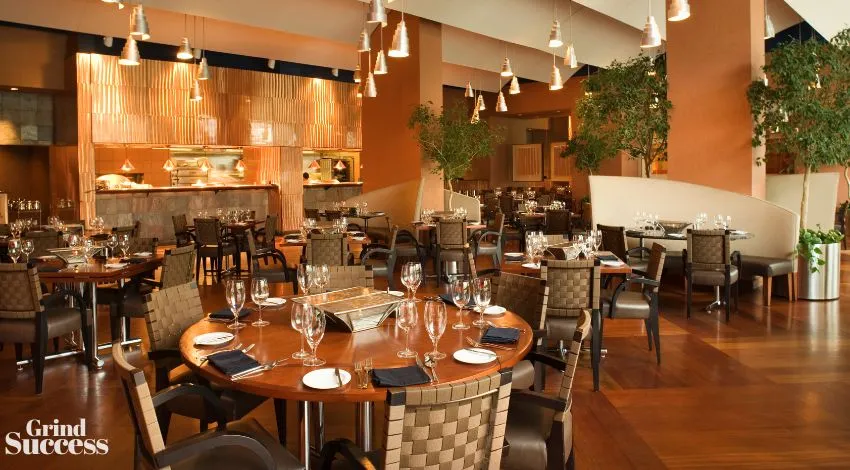
Starting a restaurant requires a lot of planning, hard work, and dedication. It involves selecting a concept, creating a menu, finding a location, obtaining permits and licenses, hiring staff, and promoting the business.
In addition, it is important to develop a strong brand, establish relationships with suppliers, and provide exceptional customer service to ensure the success of the restaurant.
With careful planning and execution, starting a restaurant can be a rewarding and fulfilling venture.
Together With Klaviyo
Companies using Klaviyo see a 95x ROI (yes, 95x)
Use Klaviyo to turn hard-earned customer data into hard-working emails and texts.
Try the platform that 265,000 brands use to grow their business.
Try it now (it’s free) ➜
The Step-by-Step Guide on How to Start a Restaurant
Regardless of your educational background or degree of expertise, nothing can fully prepare you for opening your first restaurant or, really, for opening any kind of business.
Furthermore, no matter how much you read or how much research you do, there are some aspects of being a restaurant that you can really only learn from experience. Even so, the steps listed below can assist you in avoiding some of the most typical mistakes.
1. Develop a Restaurant Business
Creating a business plan is essential for any new restaurant business. You won’t be able to fulfill your ambition of opening a restaurant without a thorough, organized business plan.
The business plan is used to lay out the complete process of starting and running a restaurant; it describes in great detail how the restaurant will develop and function once you open the doors.
Your business plan will serve as a roadmap for how to secure financing from possible investors and implement the expected financial strategy. Your business plan should include the following sections:
- Business Overview: This section should describe your restaurant concept, its location, target market, and unique selling proposition. It should also outline your business goals and mission statement.
- Industry Analysis: This section should provide an overview of the restaurant industry, including trends, growth potential, and competition. You should research your local market and analyze the demand for your restaurant concept.
- SWOT Analysis: SWOT stands for Strengths, Weaknesses, Opportunities, and Threats. Conducting a SWOT analysis will help you identify your restaurant’s strengths and weaknesses, as well as the opportunities and threats in the market. This information will help you develop strategies to overcome obstacles and take advantage of opportunities.
- Operations Plan: The operations plan should outline the day-to-day activities of your restaurant, including the menu, pricing, staffing, inventory management, and customer service. It should also include details on the legal and regulatory requirements, such as permits and licenses.
2. Get Funding for Your Restaurant
Getting funding is the next step in opening your new restaurant. Most of us don’t have enough money on hand to pay for the costs of operating a restaurant on our own.
If you can make your ambition of owning a restaurant a reality, it will depend on whether you can obtain finance from outside sources. Here are a few ways to secure funding for your new restaurant:
- Private Investment: Consider pitching your business idea to family, friends, or other potential investors who may be interested in investing in your restaurant.
- Investors: Look for investors who specialize in restaurant ventures or who have a track record of investing in startups.
- Bank Loans: Consider applying for a business loan from a bank or financial institution. Make sure to have a solid business plan and financial projections to present to the lender.
3. Apply for Restaurant Licenses and Permits
You will require a number of federal, state, and local permits and licenses in order to open a new restaurant. To ensure you don’t skip a step when applying for restaurant permits and licenses, it’s beneficial to seek legal counsel.
The following methods will assist you in getting additional information about obtaining a license and permit for a restaurant.
- Contact Your Local Government Agency: The first step in obtaining a restaurant license and permit is to contact your local government agency. This can be your city hall, county clerk’s office or health department.
They will provide you with the necessary information about the application process and the permits required for your restaurant. Some of the most common permits required are business permits, food service permits, and liquor licenses. - Check with Your State’s Department of Health: Your state’s department of health will also provide you with information on what is required to obtain a food service permit. They may have specific regulations and requirements that you must meet, such as food handling and storage, kitchen design, and sanitation standards.
- Hire a Licensing Consultant: If you are unfamiliar with the application process or if you simply do not have the time to handle it yourself, you may want to consider hiring a licensing consultant. They will assist you with all aspects of the application process, from completing the necessary forms to obtaining the required permits.
- Use Online Resources: There are several online resources available that can help you with the application process. For example, the Small Business Administration website provides information on obtaining licenses and permits, as well as other helpful resources for small business owners. Additionally, some states have online portals where you can submit your application and receive real-time updates on its progress
4. Choose the Restaurant Type
Choosing the right type of restaurant largely depends on your personal preferences, the occasion, the ambiance you’re looking for, and your budget. Although there are many various types of restaurants, in this article we’ll only discuss the biggest ones.
- Quick-Service Restaurant: Quick-service restaurants are known for their fast food and low prices. These restaurants typically offer a limited menu and quick service, making them a popular choice for busy customers.
- Fast-Casual Restaurant: Fast-casual restaurants offer high-quality food and a more upscale dining experience than quick-service restaurants. They typically have a larger menu and offer more customizable options, such as build-your-own-bowls or sandwiches.
- Ghost Restaurant: A ghost restaurant is a delivery-only restaurant that operates solely through online orders. These restaurants can save on overhead costs, such as rent and utilities, but require a strong online presence to attract customers.
- Food Truck: Food trucks offer a flexible and affordable way to start a restaurant business. They typically have a smaller menu and are ideal for serving a specific cuisine or menu item.
- Cafe: Cafes offer a casual dining experience and are known for their coffee and pastries. They can also serve light meals, such as sandwiches and salads, and can be an excellent option for breakfast and lunch.
5. Find the Right Location for a Restaurant
Choosing the right location for a restaurant can be a critical factor in its success. Here are some key considerations to keep in mind:
- Demographics of the area: Before choosing a location, consider the demographics of the surrounding area. What are the average age, income, and education level of the residents? What are their lifestyles and preferences? These factors can greatly impact the type of cuisine and atmosphere that will be successful in the area.
- Foot traffic and accessibility: A restaurant that is easily accessible and visible to potential customers is more likely to succeed. Consider the amount of foot traffic in the area, as well as the ease of parking and public transportation options. A location near popular attractions or shopping centers can also bring in more foot traffic.
- Competition: Analyze the competition in the area before choosing a location. Are there similar restaurants nearby? What is their level of success? If there are already several similar restaurants, it may be challenging to attract customers unless the restaurant offers something unique or exceptional.
- Rent and operating costs: The cost of rent and other operating expenses can significantly impact the profitability of a restaurant. Consider the rent prices and utility costs of different locations, as well as any zoning regulations or permits required in the area.
6. Invest in the Right Restaurant Equipment
Various dishes require various types of equipment. As a result, make equipment preparations after deciding on your menu, the things you want to serve at your restaurant, and how many guests you intend to serve simultaneously. Research the market to find out where to buy the best commercial kitchen equipment at a reasonable cost.
There are several ways to acquire restaurant equipment, including buying new or used equipment, leasing equipment, or even renting equipment for short-term needs.
Buying new equipment can be a great option if you have the budget for it, as you’ll be able to choose the latest models with the newest features and warranties. However, it can also be the most expensive option, and you may need to consider financing options to make the purchase more manageable.
On the other hand, buying used equipment can be a more affordable option, but you’ll need to be careful when choosing what to buy. It’s important to inspect the equipment thoroughly to make sure it’s in good working condition and won’t need costly repairs in the near future. Buying from a reputable dealer or seller can also give you some peace of mind.
Leasing equipment can be a good option if you don’t have the upfront funds to purchase new equipment or don’t want to take on the risk of buying used equipment.
With a lease, you’ll typically make regular payments over a set period of time and will be able to upgrade your equipment when the lease is up.
However, you’ll need to carefully read the lease agreement and understand the terms, including the length of the lease and any associated fees.
Overall, the best way to get restaurant equipment will depend on your budget, needs, and preferences. It’s always a good idea to do your research and compare options before making a decision.
7. Create a Restaurant Menu
When creating a restaurant menu, there are several important factors to consider. Here are a few things to keep in mind:
- Target audience: Think about who your target audience is and what kind of food they would like to eat. Consider the age group, cultural background, and preferences of your customers.
- Theme: Determine the theme of your restaurant, whether it is cuisine specific, casual, upscale, or a fusion of multiple styles.
- Menu size: Keep the menu size manageable, with a selection of dishes that are easily prepared and that can be consistently cooked to perfection.
- Seasonality: Incorporate seasonal ingredients and adjust the menu based on what is in the season to keep the menu fresh and varied.
- Pricing: Be sure to price your menu items reasonably, while also taking into account your overhead costs, the cost of ingredients, and the quality of the dishes.
- Variety: Provide a range of options to cater to different tastes and dietary restrictions such as vegetarian, vegan, gluten-free, and keto diets.
- Presentation: Think about how to present your dishes, whether through creative plating, garnishes, or other visual elements that will make them look appetizing and appealing.
- Feedback: Be open to customer feedback, whether positive or negative and use it to improve your menu and service
8. Hire and Train Your Restaurant Staff
Finding the best staff for your restaurant is essential for providing excellent service to your customers. Here are some tips on how to hire and train your restaurant staff:
- Determine your staffing needs: Before you start hiring, decide how many employees you need, what positions you need to fill, and what skills and experience are necessary for each position.
- Write a clear job description: A well-written job description will attract qualified candidates and help you to find the right fit for your team. Be specific about the duties, responsibilities, and requirements of the job.
- Advertise your job opening: Post your job opening on job boards, social media, and your restaurant’s website. You can also ask for referrals from current employees or industry colleagues.
- Conduct thorough interviews: When interviewing candidates, ask questions that will help you assess their skills, experience, and personality. Conduct thorough interviews or a working interview to see how they perform in a restaurant setting.
- Check references: Before making a job offer, check the candidate’s references to ensure they have a good track record of job performance.
Once you have hired your staff, it’s essential to train them properly to provide excellent service to your customers. Here are some tips on how to train your staff:
- Develop a training program: Create a training program that covers all aspects of your restaurant’s operations, including food safety, customer service, and sales techniques.
- Provide hands-on training: Your staff will learn best by doing, so provide them with plenty of opportunities to practice their skills in a real restaurant setting.
- Encourage teamwork: Encourage your staff to work together and support each other to create a positive work environment.
- Provide ongoing training: Training should be ongoing to keep your staff up-to-date with changes in your restaurant’s menu, policies, and procedures.
- Lead by example: As a restaurant owner or manager, you set the tone for your staff. Lead by example by providing excellent customer service, following safety protocols, and treating your staff with respect.
By hiring the right staff and providing them with proper training, you can ensure that your restaurant provides excellent service and creates a positive experience for your customers.
9. Market and Promote Your Restaurant
You may be well aware of the transformational impact of hospitality as a restaurant owner. You will distinguish yourself from rival restaurants by developing strong client relationships and providing a memorable dining experience.
The ideal place to start is by creating your restaurant’s marketing plans. There are a variety of methods for marketing your restaurant to your target audience.
Here are a few ideas to get you going:
- Use social media marketing: Social media is an excellent tool for restaurant marketing. Create profiles for your restaurant on popular platforms like Facebook, Instagram, Twitter, and Pinterest.
Share high-quality photos of your dishes, post updates on menu changes, and engage with your followers by responding to their comments and messages. You can also use social media ads to reach a wider audience and target specific demographics based on location, interests, and behavior. - Make a professional-looking website: Your restaurant’s website is often the first impression potential customers have of your business. Make sure your website is easy to navigate, visually appealing, and mobile-friendly.
Include information about your menu, hours, location, and contact information. You can also add a reservation system and online ordering to make it convenient for customers to book a table or order takeout or delivery. - Offer promotions: Promotions are an effective way to attract new customers and encourage repeat business. Offer discounts on slow days or during slow hours, create limited-time menu items or bundle meals with drinks or desserts.
You can also offer loyalty programs that reward customers for repeat visits or referrals. Don’t forget to advertise your promotions on your website, social media, and in-store signage.
The Bottom Line
Possession of your own restaurant is an endless, round-the-clock adventure, so being a restaurateur is definitely not for the faint of heart. Each restaurant owner faces different challenges and issues depending on the kinds of restaurants and states they manage.
The above-mentioned steps can be an excellent place to start if, however, food is your passion and operating a restaurant is your desire.
Author BIO:
Damon Shrauner, Senior Sales Consultant and VP of B2B Sales at CKitchen working in the food service equipment sector since 1994. With his expertise in market analysis, product placement, sales, and project management, he will always tell you what to do for the best of your business.
This post was proofread by Grammarly. Try it – It’s Free!
Millions trust Grammarly’s free writing app to make their online writing clear and effective. Getting started is simple
Promoted
Did you know that brands using Klaviyo average a 95x ROI?
Email, SMS, and more — Klaviyo brings your marketing all together, fueling growth without burning through time and resources.
Deliver more relevant email and text messages — powered by your data. Klaviyo helps you turn one-time buyers into repeat customers with all the power of an enterprise solution and none of the complexity.
Try Klaviyo for free right now ➜









